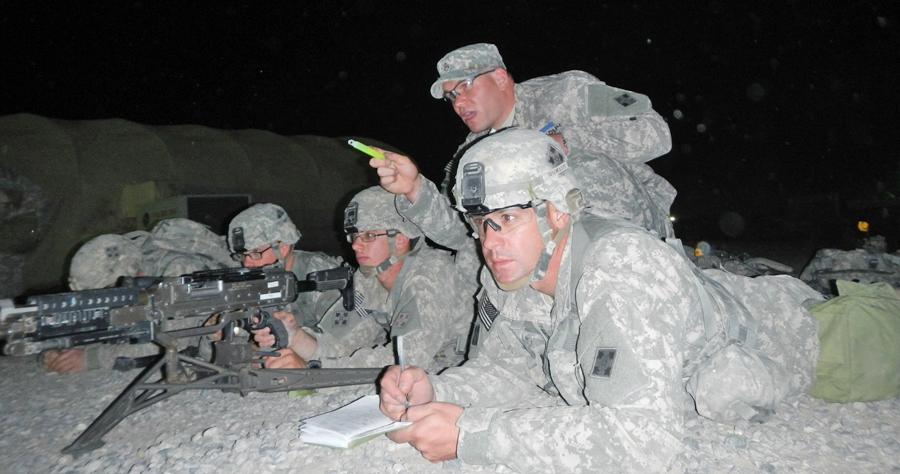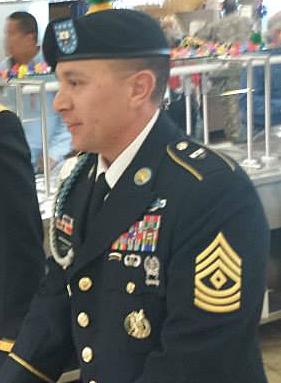![]() 1st Battalion 22nd Infantry
1st Battalion 22nd Infantry ![]()
C Co. 1SGT Article in NCO Journal

Staff
Sgt. Matthew Stankan, rifle squad leader, Company A, 1st
Battalion, 22nd Infantry Battalion, 1st Armored Brigade Combat
Team,
4th Infantry Division, trains Soldiers at the Prepare a Range
Card for a M240B station during Expert Infantryman Badge training
July 17, 2013 at Camp Buehring, Kuwait.
(Photo by 1st Lt. Shawn Pulsipher).
Refuse to be a
hollow force: Earn EIB, EIA
By NCO Journal – November 12, 2013
Posted in: From the Field
By 1ST SGT. JOHN UGARTE
1st Battalion, 22nd Infantry Regiment
As a senior noncommissioned officer with 16 years invested to the
Army I have watched this organization as well as others operate
on a limited amount of funding. This challenges leaders across
our Army by having to conserve resources while still providing
quality and realistic training to our Soldiers. Wisely allocating
funds towards training events is one way to ensure we get the
most training value for the resources expended. Before becoming a
first sergeant, I was the operations sergeant major for my
battalion. One of my responsibilities as the operations sergeant
major was to enable our organization the ability to conduct
realistic and challenging training with every round fired and
every mile driven. The Expert Infantryman’s Badge and the
Excellence in Armor training programs have been essential to the
development of our Soldiers using materials and resources readily
available to most units and provide the best training to our
Soldiers.
As budget constraints and sequestration slowly force units to
limit collective training to the platoon or squad level, these
two programs will keep our Soldiers prepared for the next chapter
in our Army’s future.
Our battalion conducted both the EIB and EIA during a recent
deployment to Kuwait.
The EIB started 69 years ago in March 1944, when ten of the
Army’s first expert infantrymen earned the coveted badge
after three days of intense testing. The very first EIB was
presented to Tech. Sgt. Walter Bull. He was one of ten that had
to endure a 25 mile foot march in eight hours as compared to
today’s 12 mile in 3 hours. Today, EIB training and testing
continues to be realistic, mission-focused and rigorous.
My battalion’s command sergeant major, Command Sgt. Maj.
Timothy Edwards, empowered the battalion’s first sergeants
and me to find resources to conduct the entire training and
testing event. Our EIB from start to finish was a completely NCO
led and driven event. The ultimate success of the EIB training
goes to show how our NCO Corps truly is the backbone of the Army.
There were three officers in our battalion that had already
earned the EIB, two majors and one captain. They coached younger
officers, trying to earn their EIB, outside of the course. Lane
NCOICs provided support where needed on the course. It was very
deliberate that this was an NCO run event; we wanted to show what
the NCO Corps was capable of.
Running a successful EIB is dependent upon researching the
correct and current information. The following website:
http://www.benning.army.mil/infantry/eib/index.html will provide
outlines for conducting in progress reviews (IPR), a digital
candidate tracker and most of the tools needed to evaluate EIB
candidates.
Our success started by having a complete and thorough plan. We
focused on ensuring that our unit used the most current copy of
U.S. Army Infantry School Pamphlet 350-6. This resource gives
detailed information on how to establish Army-wide uniformity and
will ensure your validation goes smoothly when the EIB program
manager comes to validate your training and testing sites.
The EIB must be validated and given a test control number. The
EIB course manager travels to the EIB location and over a three
day period, longer if needed, and checks every portion of the
site. The EIB course manager checks cadre EIB orders, Army
Physical Fitness Test site, land navigation course, the training
lanes, road march course and the packing list.
He also made sure we followed the standards set forth in USAIS
PAM 350-6. The course manager’s main goal is to ensure
realistic training standards are clearly defined and demonstrated
by the EIB cadre.
From that point we focused on the tasks that aligned to our
unit’s Mission Essential Task List. Some additional
considerations are the required training aids, training sites,
and ammunition required for the event. You must ensure you have
all the resources locked in as early as possible. We conducted
five IPRs in preparation for our EIB along with nightly
after-action reviews at the completion of each day of training.
The IPRs and AARs enabled us to refine and identify issues before
training began allowing Soldiers to be tested on one set
standard.
Our friction points were the APFT, day-land navigation, lane
testing, and 12 mile foot march. These events whittled down our
EIB success rate to fewer than 20 percent.
Our battalion started with 258 EIB candidates, when the dust
settled, five days later, 51 had earned the EIB. When I see a
young private in the battalion area wearing his newly earned EIB,
I know instantly how proud my NCOs felt when I earned mine 13
years ago.
But, it was a difficult task for those 51 that earned the badge.
A candidate must pass the APFT with at least 75 percent, in their
age group, in each event. The APFT cut 89 Soldiers on the first
day of testing. Most failed on the pushups or run. Day-land
navigation resulted in 29 Soldiers failing because of resection
miscalculations. During lane testing, intersection, range cards,
nine-line medevac, and “call for fire” resulted in the
most overall “no-go’s” removing another 68
candidates.
The final obstacle, the 12 mile foot march proved to be too
difficult for 21 of the 72 that started the three-hour task.
Another outstanding training tool is the Excellence in Armor
program, formerly known as Fast Track. The EIA was initially
proposed in May 1984. However, the program was not approved for
implementation until October 1987. Today the EIA program rewards
outstanding armor and cavalry Soldiers whose performance is
routinely above the standard and demonstrates superior leadership
potential. Again the key to success is research. The most recent
memorandum of instruction is dated December 2011 can be found at
the following website:
http://www.benning.army.mil/armor/OCOA/Excellence%20in%20Armor.htm
To sustain a successful EIA program, a unit must be dedicated to
keeping it a priority because the program lasts at least six
months.
The EIA is a long process because the unit must first identify
which Soldiers qualify for the program. Qualified Soldiers must
score a 260 or above on the APFT, qualify sharpshooter or better
with their individual assigned weapon and complete all Warrior
Training Tasks (WTT) with first time “go’s” as
chosen by the battalion commander. They must also receive first
time go’s on the gunnery skills test. The completion of
these tasks will enroll qualified Soldiers into the unit level
EIA.
EIA enrollment earns a Soldier a Certificate of Achievement and
coin from the Chief of Armor. EIA completion will earn the
Soldier the skill identifier “E4J” which will be added
to their enlisted record brief and will set the Soldier apart
from his peers during promotion boards.
Sergeants will take the Tank/Scout Commander Competency Test
(TCCT/SCCT). If they pass with a score of at least 70 percent
they will be awarded 50 promotion points.
Other training for the EIA includes: M-2 .50 caliber machine gun
maintenance, functions check, etc., M240 proficiency, vehicle
identification, ammunition identification and bore sighting the
M-1 Abrams weapons systems.
Our unit conducted several IPRs and rehearsals until our leaders
felt comfortable with the overall concept of our program. The
most difficult portion for the Soldiers is accomplishing the
required training throughout a prolonged length of time.
The dedication of 1st Sgt. Jon D. Noyes and Staff Sgt. Aaron J.
Keen made our EIA successful. Noyes is the Company D first
sergeant and Keen is the battalion’s tank master gunner.
Their dedication to the EIA for the armor and cavalry Soldiers
resulted in the induction of 34 new members throughout the
deployment for the battalion. Noyes himself was inducted eleven
years ago and continues the proud tradition today after twenty
six years since its conception.
During my time as the operations sergeant major, I oversaw
multiple squad, platoon and company collective training events,
none of which would have been successful without the base
knowledge obtained through quality skill level-one training
provided by our NCOs. The ammunition and training aids required
to run EIB training and maintain an EIA program is minimal in
comparison to the level of basic Soldier skill proficiency the
training provides Soldiers. During our nine-month deployment to
Camp Buehring, Kuwait, our NCOs conducted both a successful EIB
and continued to maintain an EIA program. At the end of the day
the Eight Step Training Model is the number one key to conducting
both an EIB and EIA with successful results. Using the Eight Step
Training Model gives units a complete checklist when setting up
and conducting any training event.
Our Soldiers and noncommissioned officers have adapted to both
the environment and fluid mission sets in support of Operation
Enduring Freedom (Spartan Shield). We refuse to be a hollow
force, fully displaying the spirit of the Warrior Ethos: “I
will always place the mission first, I will never accept defeat,
I will never quit and I will never leave a fallen comrade.”

1SGT John S. Ugarte
November 2013
1st Sgt. John S. Ugarte is currently the Charlie
Company, 1st Battalion, 22nd Infantry Regiment
“Regulars”, 1st Armored Brigade Combat Team, 4th
Infantry Division First Sergeant at Fort Carson, Colo. His
previous assignment was as operations sergeant major of the 1-22
Infantry Regiment. In his 16-year Army career, he has deployed to
Macedonia, Kuwait and Iraq.
Home | Photos | Battles & History | Current |
Rosters & Reports | Medal of Honor | Killed
in Action |
Personnel Locator | Commanders | Station
List | Campaigns |
Honors | Insignia & Memorabilia | 4-42
Artillery | Taps |
What's New | Editorial | Links |